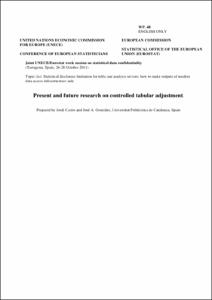Mostra el registre d'ítem simple
Present and future research on controlled tabular adjustment
| dc.contributor.author | Castro Pérez, Jordi |
| dc.contributor.author | González Alastrué, José Antonio |
| dc.contributor.other | Universitat Politècnica de Catalunya. Departament d'Estadística i Investigació Operativa |
| dc.date.accessioned | 2013-01-17T17:57:13Z |
| dc.date.available | 2013-01-17T17:57:13Z |
| dc.date.created | 2011 |
| dc.date.issued | 2011 |
| dc.identifier.citation | Castro, J.; Gonzalez, J. Present and future research on controlled tabular adjustment. A: Joint UNECE/Eurostat Work Session on Statistical Data Confidentiality. "Work Session on Statistical Data Confidentiality". Tarragona: 2011, p. 1-10. |
| dc.identifier.uri | http://hdl.handle.net/2117/17410 |
| dc.description.abstract | Controlled tabular adjustment (CTA) can be classi ed within the group of approaches that perturb output data (i.e., tabular data), unlike other methods that focus on the original microdata. Being a post-tabular data perturbation technique it becomes easier to guarantee consistency and quality of the released information (e.g., table additivity, preservation of subtotal or total cells of the original table, etc.). On the other hand, it may be computationally more costly than pre-tabular strategies. The purpose of this work is twofold. First, we will review a recently used heuristic to suboptimally solve CTA (which is a mixed integer linear optimization problem). For some tables this heuristic provided decent solutions much faster than other state-of-the-art optimization methods. This approach can be useful when CTA is applied to a pre-de ned "static" set of tables. The second goal of the paper is to provide and discuss variants of CTA when applied in an on-line table generation system. In this case, tables can be dynamically generated over time, and CTA has to face two new challenges: (i) it has to deliver an on-line fast solution; (ii) protection senses of sensitive cells have to be consistent (i.e, the same) when the same sensitive cell appears in two (or more) tables which are generated and protected at di erent moments. Some of these ideas will be implemented in the recently started Data without Boundaries FP7 EU project. |
| dc.format.extent | 10 p. |
| dc.language.iso | eng |
| dc.rights | Attribution-NonCommercial-NoDerivs 3.0 Spain |
| dc.rights.uri | http://creativecommons.org/licenses/by-nc-nd/3.0/es/ |
| dc.subject | Àrees temàtiques de la UPC::Matemàtiques i estadística::Estadística matemàtica |
| dc.subject.lcsh | Mathematical statistics |
| dc.title | Present and future research on controlled tabular adjustment |
| dc.type | Conference report |
| dc.subject.lemac | Estadística matemàtica |
| dc.contributor.group | Universitat Politècnica de Catalunya. GNOM - Grup d'Optimització Numèrica i Modelització |
| dc.identifier.doi | 10.2901/Eurostat.C2007.004 |
| dc.subject.ams | Classificació AMS::62 Statistics |
| dc.relation.publisherversion | http://www.unece.org/fileadmin/DAM/stats/documents/ece/ces/ge.46/2011/48_Castro-Gonzalez.pdf |
| dc.rights.access | Open Access |
| local.identifier.drac | 8579478 |
| dc.description.version | Preprint |
| local.citation.author | Castro, J.; Gonzalez, J. |
| local.citation.contributor | Joint UNECE/Eurostat Work Session on Statistical Data Confidentiality |
| local.citation.pubplace | Tarragona |
| local.citation.publicationName | Work Session on Statistical Data Confidentiality |
| local.citation.startingPage | 1 |
| local.citation.endingPage | 10 |


